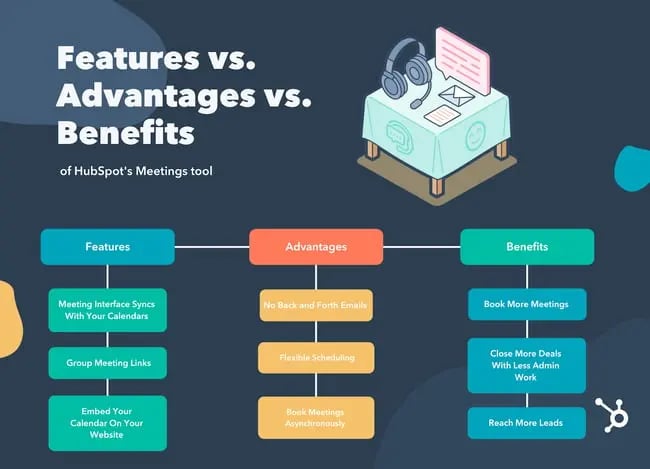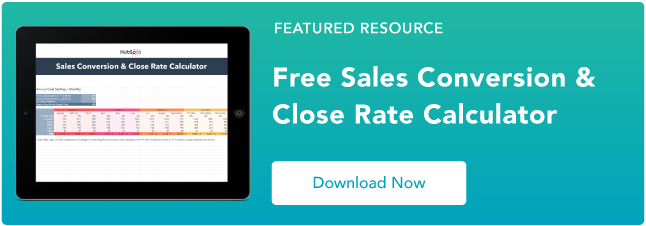Salespeople are often told to sell benefits, not just features. But the distinction can sometimes feel blurry. Is the product’s ability to scale with a prospect’s growth a feature or a benefit? What about its best-in-class quality? Or its ease of use?

Understanding the difference between features, advantages, and benefits is crucial to a rep’s success. A truly holistic approach to selling means conveying all three of these elements to prove the business's value to prospects.
![Download Now: Sales Conversion Rate Calculator [Free Template]](https://no-cache.hubspot.com/cta/default/53/059a7eef-8ad9-4bee-9c08-4dae23549a29.png)
Table of Contents
Features, Advantages, and Benefits
How to Sell Benefits Rather Than Features
Features vs. Benefits
Features tell, benefits sell. Features are often technical in nature, describing what the product or service does. Benefits, on the other hand, paint a picture of success in the prospect's mind of how it will change their life in some way.
Both features and benefits are valuable information to give prospects during their buyer's journey. But ultimately, most customers are swayed to make a purchase based on the benefits. That said, if you're in a competitive, highly-saturated market, it's better to lean into your product's features, allowing potential customers to weigh your competitive advantage.

Feature-Benefit Selling Examples
Here are a few feature-benefit examples that appeal to customers with different needs.
1. HelloFresh
Feature: A mean kit delivered right to your door with step-by-step recipes and pre-measured ingredients.
Benefit #1: You can ditch the “what do you want to eat?” conversation.
Benefit #2: You can save time finding recipes, going to the the grocery store, and cleaning up afterwards.
2. Slack
Feature: An instant messaging app that allows teams to communicate via text messages, video, and audio huddles
Benefit #1: It's faster than email and messages are better organized.
Benefit #2: It gives teams a more efficient and productive way to stay in sync.
3. Canva
Feature: An online design tool with pre-made templates and layouts.
Benefit #1: You can save money by creating graphics yourself instead of hiring a graphic designer.
Benefit #2: No design experience necessary.
During the qualification process, you'll get to know your prospect's pains intimately, so part of the challenge will be mapping those features into benefits to drive the point home.
You can do that by identifying advantages, which bridge the gap between features and benefits (more on that later). However, the distinction between advantages and benefits is trickier.
Advantages vs. Benefits
Advantages explain the significance of a feature and how it solves a problem, often in a factual, concrete, or measurable way. Benefits, on the other hand, are subjective and appeal to the emotions or pains of the prospect.
In essence, advantages are why the features matter, and benefits are why the advantages matter.
Because features are the nuts and bolts of the thing and people make decisions based on emotion, selling on features alone is not enough.
It's the benefits that convince them to buy.
Features vs. Advantages vs. Benefits
Features describe the attributes of a product or service. Consider it 'the what' the consumer is getting. Advantages describe the factual significance of the feature. Consider it 'the how' it provides value to the consumer. Benefits describe why the advantage is valuable in a way that emotionally connects with the consumer. Consider it 'the why' that value matters for the consumer.
For a deeper understanding of features, advantages, and benefits, take a look at this video by Adam Erhart.
Example of Features, Advantages, and Benefits
Using HubSpot's Meetings tool as an example, here's how to break down features, advantages, and benefits.

- Example Feature - HubSpot's Meetings tool provides an interface that is synced to your Google or Office 365 calendar.
- Example Advantage - Prospects select the meeting time that works for them without back and forth email communication.
- Example Benefit - You'll be able to reach more leads, book more meetings, and close more deals with less admin work.
Next, let's take a dive into features vs. benefits to better understand the difference.
How to Sell Benefits Rather Than Features
Reps cannot properly explain their product’s benefits without knowing their buyer’s goals, challenges, and desires. As the above example shows, what appeals to one prospect might not resonate with another.
Asking the right discovery questions is necessary but not sufficient. Once salespeople have properly assessed their prospect’s situation, they must map each feature to their prospect’s needs. The link between capability and problem or desire turns a feature into a benefit.
It may be helpful for reps to ask themselves, “So what?”
For example, let’s say a salesperson is pitching her user research firm’s services to the head of product at a startup.
Her original statement might be: “We handle every stage of the user research process, from finding participants and designing questions to analyzing the results and creating a report.”
She asks herself, “So what?”
That question leads the salesperson to add: “You’ve mentioned how quickly your team needs to move. By outsourcing the user research process, you can take products from idea to launch at least two weeks faster — which will give you a huge competitive advantage.”
Answering the silent “So what?” in their explanation forces salespeople to personalize their messaging.
When explaining benefits, quality beats quantity.
Salespeople are often tempted to explain every feature of their product. Yes, prospects want to get their money’s worth — but they usually don’t equate more features with higher value.
When a rep throws the kitchen sink at the buyer, two things happen. First, the buyer feels like the salesperson doesn’t truly “get” him or his situation. He’s invested time and energy into answering the rep’s questions, so why is he getting a one-size-fits-all explanation?
Second, the salesperson inadvertently deemphasizes the details that truly matter to her prospect. If she spends five minutes on two points, she can highlight why those items are so important. Yet if she spends that same five minutes on four points, she can’t explore them to the same degree. Rather than learning about two things that really interest him, the buyer gets a rushed discussion of two things that interest him and two things he doesn’t care about.
The takeaway? To successfully sell benefits, salespeople must leave out the information that doesn’t pertain to their prospects. Before they provide a new detail, they should ask themselves, “Will this aspect of the product help the buyer achieve their goals or alleviate their pain?” If the answer is no, they should skip it.
Selling the Sizzle, Not the Steak
Famous salesman Elmer Wheeler, coined the phrase "sell the sizzle, not the steak" in the 1920s. More than 100 years later, that phrase still applies. What Wheeler meant by this is that the sizzle is just as enticing, if not more so, than the steak itself because it contributes to the experience and emotion that comes with eating a steak.
Said in today's terms, prospects won't typically make a purchase unless they can see how the product will improve their lives. The purchase should solve a pain point for the customer that makes their overall experience better. To bring this old saying to life, reps should focus on selling benefits instead of features.
Editor's note: This post was originally published in October 2016 and has been updated for comprehensiveness.





![What is Enterprise Sales? [+ How It Differs From SMB and Mid-market Sales]](https://www.hubspot.com/hubfs/Sales%20Enterprise.png)




